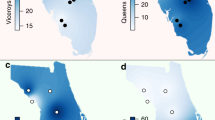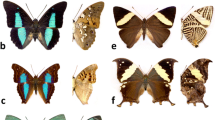Summary
Understanding the dynamics of defensive mimicry requires accurately characterizing the comparative palatability of putative models and mimics. The Florida viceroy butterfly (Limenitis archippus floridensis) is traditionally considered a palatable Batesian mimic of the purportedly distasteful Florida queen (Danaus gilippus berenice). I re-evaluated this established hypothesis by directly assessing palatability of viceroys and queens to red-winged blackbirds in a laboratory experiment. Representative Florida viceroys were surprisingly unpalatable to red-wings; only 40% of viceroy abdomens were entirely eaten (compared to 98% of control butterfly abdomens), and nearly one-third were immediately tasterejected after a single peck. In fact, the viceroys were significantly more unpalatable than representative Florida queens, of which 65% were eaten and 14% taste-rejected. Thus, viceroys and queens from the sampled populations exemplify Müllerian rather than Batesian mimicry, and the viceroy appears to be the stronger model. These findings prompt a reassessment of the ecological and evolutionary dynamics of this classic mimicry relationship.
Similar content being viewed by others
References
Ackery PR (1987) Hostplants and classification: a review of nymphalid butterflies. Biol J Linn Soc 33:95–203
Alcock J (1973) The feeding response of hand-reared red-winged blackbirds (Agelaius phoeniceus) to a stinkbug (Euchistus conspersus). Am Midl Nat 89:307–313
Argus GW (1986) The genus Salix (Salicaceae) in the southeastern United States. Systematic Botany Monogr., vol. 9 (Amer. Soc. of Plant Taxonomists)
Bates HW (1962) Contributions to an insect fauna of the Amazon valley (Lepidoptera: Heliconidae). Trans Linn Soc Lond 23:495–56
Benson WW (1977) On the supposed spectrum between Batesian and Müllerian mimicry. Evolution 31:454–455
Boppré M (1984) Chemically mediated interactions between butterflies. In: Vane-Wright RI, Ackery PR (eds) The Biology of Butterflies. Academic Press, London, pp. 259–275
Bowers MD (1980) Unpalatability as a defense strategy of Euphydryas phaeton. Evolution 34:586–600
Brower JVZ (1958a) Experimental studies of mimicry in some North American butterflies. I. The Monarch, Danaus plexippus and Viceroy, Limenitis archippus. Evolution 12:32–47
Brower JVZ (1958b) Experimental studies of mimicry in some North American butterflies. III. Danaus gilippus berenice and Limenitis archippus floridensis. Evolution 12:273–285
Brower LP (1984) Chemical defence in buterflies. In: Vane-Wright RI, Ackery PR (eds) The Biology of Butterflies. Academic Press, London, pp. 109–134
Brower LP (1988) Preface. In: Brower LP (ed) Mimicry and the evolutionary process. University of Chicago Press, Chicago, pp. 1–3
Brower LP, Glazier SC (1975) Localization of heart poisons in the monarch butterfly. Science 188:19–25
Brower LP, Edmunds M, Moffitt CM (1975) Cardenolide content and palatability of a population of Danaus chrysippus butterflies from West Africa. J Entom (A) 49:183–196
Cohen JA (1985) Differences and similarities in cardenolide content of queen and monarch butterllies in Florida and their ecological and evolutionary implications. J Chem Ecol. 11:85–103
Coppinger RP (1970) The effect of experience and novelty on avian feeding behavior with reference to the evolution of warning coloration in butterflies. II. Reactions of naive birds to novel insects. Am Nat 104:323–335
Day RW, Quinn GP (1989) Comparisons of treatments after an analysis of variance in ecology. Ecol Monogr 59:433–463
Edwards WRN (1978) Effect of salicin content on palatability of Populus foliage to opossum (Trichosurus vulpecula). New Zealand J Sci 21:103–106
Fisher RA (1958) The Genetical Theory of Natural Selection, 2nd ed. Dover Pub.. NY
Guilford T (1988) The evolution of conspicuous coloration. Am Nat 131 (Suppl.):7–21
Howe WH (1975) The butterflies of North America north of Mexico. Doubleday and Co., Garden City, NY
Huheey JE (1976) Studies in warning coloration and mimicry. VII. Evolutionary consequences of a Batesian-Müllerian spectrum: A model for Müllerian mimicry. Evolution 30:86–93
Huheey JE (1980) Batesian and Müllerian mimicry: Semantic and substantive differences of opinion. Evolution 34:1212–1215
Huheey JE (1984) Warning coloration and mimicry. In: Bell WJ, Cardé RT (eds), Chemical Ecology of Insects. Chapman and Hall, Ltd., London, pp. 257–297
Huheey JE (1988) Mathematical models of mimicry. Am Nat 131:S22-S41
Kimball CP (1965) Lepidoptera of Florida (Arthropods of Florida and neighboring land areas, vol. 1). Division of Plant Industry, Gainesville, Florida
Malcolm SB (1990) Mimicry: status of a classic evolutionary paradigm. Trends in Ecol, Evol 5:57–62
Mason JR, Reidinger RF (1982) Observational learning of food aversions in red-winged blackbirds (Agelaius phoeniceus). Auk 99:548–554
Myers J, Brower LP (1969) A behavioural analysis of the courtship pheromone receptors of the queen butterfly, Danaus gilippus berenice. J Insect Physiol 15:2117–2130
Opler PA, Krizek GO (1984) Butterflies East of the Great Plains. Johns Hopkins University Press, Baltimore, MD
Pasteels JM, Rowell-Rahier M, Braekman JC, Dupont A (1983) Salicin from host plant as precursor of salicylaldehyde in defensive secretion of Chrysomeline larvae. Physiol Entomol 8:307–314
Platt AP (1983) Evolution of North American admiral butterflies. Bull Entom Soc Am 29:10–22
Platt AP, Coppinger RP, Brower LP (1971) Demonstration of the selective advantage of mimetic Limenitis butterflies presented to caged avian predators. Evolution 25:692–701
Pliske TE (1975) Attraction of Lepidoptera to plants containing pyrrolizidine alkaloids. Environ Entom 4:455–473
Ritland DB (1991a) Unpalatability of queen butterflies (Danaus gilippus) feeding on Sarcostemma clausum (Asclepiadaceae) in Florida. J Chem Ecol 17 (8) (in press)
Ritland DB (1991b) Reassessment of viceroy butterfly (Limenitis archippus) mimicry and an analysis of the ecological dynamics of mimicry. Ph. D. dissertation, University of Florida, Gainesville
Ritland DB (1991c) Revising a classic butterfly mimicry scenario: Demonstration of Müllerian mimicry between Florida viceroys (Limenitis archippus floridensis) and queens (Danaus gilippus berenice). Evolution 45:918–934
Ritland DB, Brower LP (1991a) A reassessement of the mimicry relationship among viceroys, queens and monarchs in Florida. In: Malcolm SB, Zalucki MP (eds), Biology and Conservation of the Monarch Butterfly. Natural History Museum of Los Angeles County, Contributions in Science (in press)
Ritland DB, Brower LP (1991b) The viceroy butterfly is not a Batesian mimic. Nature 350:497–498
Roeske CN, Seiber JN, Brower LP, Moffitt CM (1976) Milkweed cardenolides and their comparative processing by monarch butterflies Danaus plexippus L.. Rec Adv Phytochem 10:93–167
Scott JA (1986) The Butterflies of North America: A Natural History and Field Guide. Stanford University Press, Stanford
Scudder SH (1870) Is mimicry advantageous? Nature 3:147
Siegel S (1956) Nonparametric Statistics for the Behavioral Sciences. McGraw-Hill, NY
Turner JRG (1977) Butterfly mimicry: the genetical evolution of an adaptation. Evol Biol 10:163–206
Turner JRG (1987) The evolutionary dynamics of batesian and muellerian mimicry: similarities and differences. Ecol Entomol 12:81–85
Turner JRG, Kearney EP, Exton LS (1984) Mimicry and the Monte Carlo predator: the palatability spectrum and the origins of mimicry. Biol J Linn Soc 23:247–68
Urquhart FA (1987) The monarch butterfly: international traveler. Nelson-Hall, Chicago
Walsh BD, Riley CV (1869) Imitative butterflies. Am Entomol 1:189–93
Fiklund C, Jarvi T (1982) Survival of distasteful insects after being attacked by naive birds: a reappraisal of the theory of aposematic coloration evolving through individual selection. Evolution 36:998–1002
Witthohn K, Naumann CM (1987) Cyanogenesis-a general phenomenon in the Lepidoptera? J Chem Ecol 13:1789–1809
Author information
Authors and Affiliations
Rights and permissions
About this article
Cite this article
Ritland, D.B. Unpalatability of viceroy butterflies (Limenitis archippus) and their purported mimicry models, Florida queens (Danaus gilippus). Oecologia 88, 102–108 (1991). https://doi.org/10.1007/BF00328409
Received:
Accepted:
Issue Date:
DOI: https://doi.org/10.1007/BF00328409




